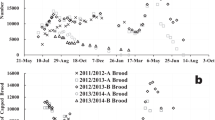Summary
The brood survival in honeybee workers was measured in order to obtain the data basic to the preparation of life tables. Under normal condition, that is, at the center of brood area, the survival is high. The survival/stage function runs 100.0 eggs, 94.2 unsealed brood (=feeding larvae), 86.4 sealed brood (=post-feeding larvae and pupae) and 85.1 adults. The total duration of immature stages is 20 days in 87.1%, 21 days in 8.3% and 19 days or more than 22 days in the residual fraction of successfully emerging workers.
The survival remarkably decreases at peripheral areas within the hive. Various factors affecting the brood survival are discussed and the importance of a dense worker cover on the brood area is stressed in relation to the maintenance of thermal conditions optimal to the brood. The occurrence of one factor, which is not expected in solitary animals, the self-control of population by egg eating, is pointed out.
Similar content being viewed by others
References
Bodenheimer, F. S. (1937) Studies in animal population. II. Seasonal population trends of the honey bee.Quart. Rev. Biol. 12: 406–425.
Brian, A. D. (1951) Brood development inBombus agrorum.Ent. Mon. Mag. 87: 207–212.
Brian, M. V. (1965)Social insect populations. viii+135pp. Academic Press, London and New York.
Fukuda, H. andK. Sekiguchi (1966) Seasonal change of the honeybee worker longevity in Sapporo, North Japan, with notes on some factors affecting the life-span.Jap. J. Ecol. 16: 206–212.
Hachinoe, Y. andM. Jimbu (1958) Occurrence of the lethal eggs in the honeybee.Bull. Nat. Inst. Agric. Sci. Ser. G (Animal Husbandry) 14: 123–130 (In Japanese with English summary).
Himmer, A. (1927) Der soziale Wärmehaushalt der Honigbiene. II. Die Wärme der Bienenbrut.Erlangener Jb. Bienenkd. 5: 1–32.
Jay, S. C. (1963) The development of honeybees in their cells.J. Apic. Res. 2: 117–134.
Merrill, J. H. (1924) Sealed and unsealed brood.Amer. Bee. J. 64: 424–425.
Millum, V. C. (1930) Variations in time of development of the honey bee.J. Econ. Ent. 23: 441–447.
Myser, W. C. (1952) Ingestion of eggs by honey bee workers.Amer. Bee J. 92: 67.
Sakagami, S. F., Akahira, Y. andR. Zucchi (1967) Nest architecture and brood development in a Neotropical bumblebee,Bombus atratus.Insectes Sociaux 14: 389–414.
Sekiguchi, K. andS. F. Sakagami (1966) Structure of foraging population and related problems in the honeybee, with considerations on the division of labour in bee colonies.Hokkaido Nat. Agric. Exp. Sta. Rep. 69: 65pp.
Woyke, J. (1962) The hatchability of ‘lethal’ eggs in a two sex-allele fraternity of honeybees.J. Apic. Res. 1: 6–13.
Woyke, J. (1963) What happens to diploid drone larvae in a honeybee colony.——Ibid.2: 73–75.
Author information
Authors and Affiliations
Additional information
Contribution No. 801 from the Zoological Institute, Faculty of Science, Hokkaido University, Sapporo, Japan.
Population and bioeconomic studies on the honeybee colonies. I.
We thank Mr.H. Takahashi, Laboratory of Agricultural Physics, Hokkaido University, for his kind help as to the meteorological condition in Sapporo, and Prof.C. D. Michener, University of Kansas, who read through the manuscript.
Rights and permissions
About this article
Cite this article
Fukuda, H., Sakagami, S.F. Worker brood survival in honeybees. Res Popul Ecol 10, 31–39 (1968). https://doi.org/10.1007/BF02514731
Issue Date:
DOI: https://doi.org/10.1007/BF02514731




